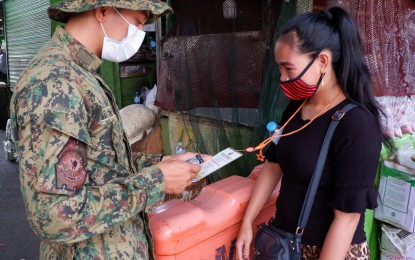
CHECKPOINT. A police personnel checks a woman's quarantine pass at the Cloverleaf Market in Balintawak, Quezon City on April 15, 2020. Authorities are implementing stricter rules to curb the spread of the coronavirus disease 2019 (Covid-19). (PNA photo by Robert Oswald P. Alfiler)
MANILA – The enhanced community quarantine (ECQ) in the entire Luzon remains effective until April 30, Malacañang clarified on Friday.
The clarification was made after President Rodrigo Duterte approved the proposed implementation of ECQ in select areas that are deemed at “high risk” for the coronavirus disease 2019 (Covid-19), as well as the imposition of a general community quarantine (GCQ) in “moderate- and low-risk” areas.
In a virtual presser aired on state-run PTV-4, Presidential Spokesperson Harry Roque said the ECQ and GCQ enforcement would take effect only from May 1 to 15.
“Bagama’t may mga area ngayon na sinabi na mapapasailalim sa GCQ, ang effectivity po ng GCQ ay May 1. Sa ngayon po, lahat po tayo ay nasa ilalim ng ECQ (Although there are areas that will be under GCQ, its effectivity will be on May 1. As of now, we are still under ECQ),” Roque said.
Metro Manila, Central Luzon, Calabarzon, and other high-risk areas will remain under ECQ until May 15, subject to evaluation to determine whether it can be relaxed afterward.
“I-maintain ang current ECQ sa NCR (Metro Manila), Region 3 (Central Luzon), Region 4-A (Calabarzon), and iba pang mga lugar na mataas po ang risk hanggang May 15 and to evaluate further pagkatapos po ng May 15 (The current ECQ will be maintained in the NCR, Region 3, Region 4-A, and other high-risk areas until May 15. It will be evaluated further after May 15),” Roque said.
Strict home quarantine, work stoppage and suspended mass public transportation have been implemented in areas under ECQ.
Meanwhile, the movement of people in areas under GCQ would be limited to accessing basic necessities and work.
He said the GCQ in low-risk provinces might be relaxed by May 15, in case there is “no deterioration in condition.”
Situation in areas under ECQ, GCQ
Roque noted that in areas under ECQ and GCQ, all airports and seaports would be opened for “movement of goods only.”
Starting May 1, there will also be several changes in areas under GCQ, he said.
In areas under GCQ, workers would be allowed to go out and work in phases, Roque said, adding that the government would also authorize the “100 percent” opening of agriculture, fishery, and forestry; food manufacturing; food retail; health care; logistics; water; energy; Internet and telecommunications; and media.
He added that the “50 to 100 percent” opening of electronics and exports; electric commerce and delivery of essential and non-essential items; repair and maintenance services; and housing and office services in moderate- to low-risk areas are likewise approved.
Roque said the “50 percent” on-site work and “50 percent” work-from-home scheme of financial services; business process outsourcing; other non-leisure wholesale and retail trade; and other non-leisure services would be applied in areas under GCQ beginning May 1.
Restricted mall opening, resumption of priority and essential construction projects, buying of goods and services, operation of some public transport modes, and enforcement of curfew at night for non-workers would also be observed in moderate- to low-risk areas, he said.
Supermarkets, drugstores, banks, laundry service, restaurants offering takeout or delivery, and hardware can resume operations once GCQ is implemented, Roque added.
People aged 21 years to 59 years would be allowed to go to malls, so long as they have identification cards and are not sick, undergo mandatory temperature checks, wear a face mask, and use alcohol.
Mall operators are required to limit the number of people inside the establishment, set the air conditioning’s temperature to 26 degrees, remove free Wi-Fi, and provide face masks and gloves to employees.
Local government units (LGUs) in areas under GCQ should also consider “reprioritizing” the distribution of cash relief under the Special Amelioration Program (SAP) to people living in high-risk areas, Roque said.
Interior Secretary Eduardo Año, who joined Roque at the virtual presser, noted that more than 91 percent of funds for the implementation of the SAP had been downloaded to LGUs.
“Ngayon na nasa LGU na ang pera, sisiguruhin namin na makakapag-comply sila (Now that the LGUs have received the money, we will make sure that they are complying),” Año said. “’Yung mga hindi nabayaran, lalo na dito sa Luzon, babalikan natin at ibibigay natin yung amelioration (Those who are did not receive the money, especially those from Luzon, will get the amelioration).”
Roque said LGUs should also consider allowing the higher education institutions’ school year to finish and give credentials to students.
He added that there was also a proposal from the Department of Education (DepEd) to resume classes by September.
Roque, however, said the recommendation would still be “subject to compliance with the law.”
Acting Socioeconomic Planning Secretary Karl Kendrick Chua said the DepEd is expected to present new recommendations to the Inter-Agency Task Force for the Management of Emerging Infectious Diseases (IATF-EID).
“Hintayin na lang po natin ang DepEd kung mag-present. Ang IATF ang magsabi kung policy na (Let’s just wait for the DepEd’s presentation. The IATF will decide whether it will become a policy),” Chua said.
Under the law, the school opening shall start on the first Monday of June but not later than the last day of August. (PNA)
